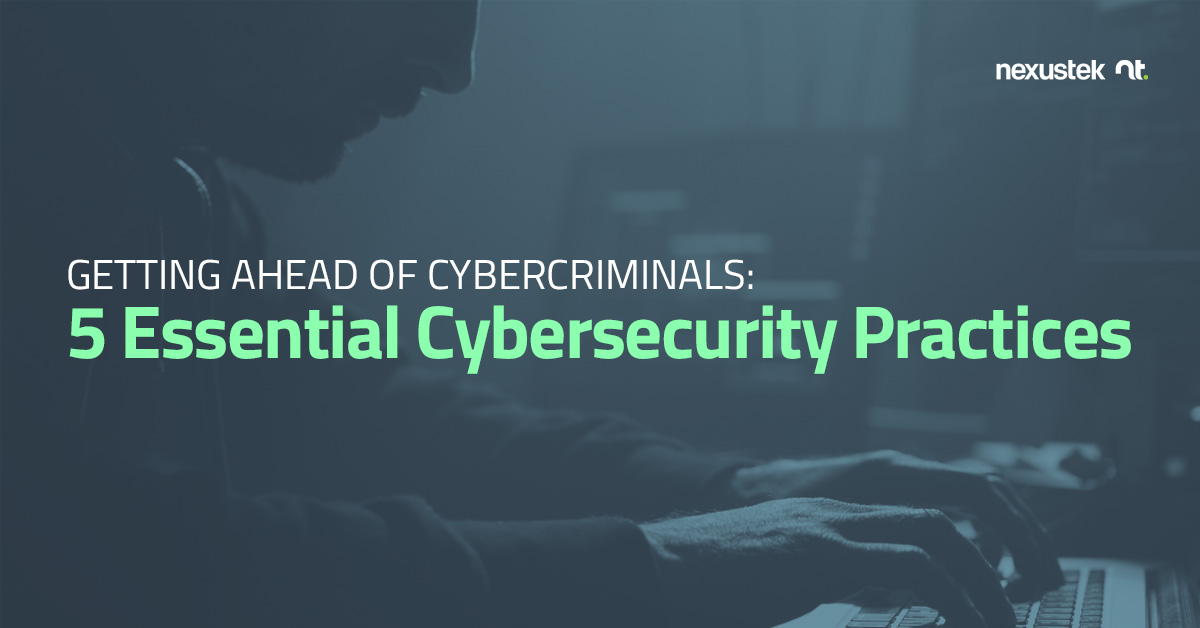
- November 11, 2024
Getting Ahead of Cybercriminals: 5 Essential Cybersecurity Practices
Ransomware attacks that hold large, prominent companies’ networks “hostage” pending multi-million-dollar ransom payments make for attention-grabbing media coverage. We’re much less likely to hear news stories about cyberattacks on small and medium-sized businesses (SMBs), which might give you the impression that smaller businesses are less likely to be victimized by cybercriminals. “Did you know, however, that 43% of cyberattacks target SMBs1?
This may come as a shock, as the resources of smaller businesses are dwarfed by those of large companies. Although you might assume this would make SMBs less attractive targets for cybercrime, consider the following2:
- SMBs often have less sophisticated security practices, making them easier targets for cybercriminals.
- Lack of cybersecurity knowledge within SMBs may result in failure to recognize that a security breach has occurred, giving criminals ample opportunity to obtain sensitive information.
- SMBs are less likely to report cybersecurity breaches to law enforcement, making them less risky targets for cybercriminals.
If you’re finding the prospect of staying ahead of cybercriminals overwhelming, you’re in good company: 88% of SMB leaders view their businesses as vulnerable to cybercrime3. However, many of these leaders share that they don’t know quite where to start to protect their businesses.
The first step in cultivating a security strategy is to understand your sources of risk. The following is a list of five essential cybersecurity practices, along with descriptions of the underlying risks they address:1
1. Cybersecurity Awareness Training
Why Is This Important?
Social engineering attacks, such as phishing and smishing, harness psychological manipulations aimed at tricking employees into clicking on links or sharing confidential information. All it takes is one employee to fall for a social engineering ploy for a security breach to occur. This is why employee error is the #1 cybersecurity risk your business faces; cybersecurity awareness training is the best way to counter this threat. In fact, businesses that offer awareness training can cut their cybersecurity risk by up to 70%4.
2. Install Patches and Updates Immediately
Why Is This Important?
Patches and updates are routinely required to address known vulnerabilities that cybercriminals can target. Staying on top of patches and updates is vital to keeping hackers out of your systems, but busy professionals often delay installations as they attend to competing priorities. Make it a priority to ensure your software and operating systems stay current.
3. Proactive Monitoring
Why Is This Important?
Although you might imagine that you would easily recognize if your systems had been penetrated, many breaches are not obvious to the untrained eye. In fact, the average length of time between breach and detection is over 6 months5. Proactive 24/7 monitoring of your systems by a certified engineer ensures that any breaches are identified quickly so that you can respond immediately.
4. Vulnerability Scanning
Why Is This Important?
Every device—remote or in-office—that is connected to your organization’s network creates a possible entry point for hackers. With the rise in remote work and bring-your-own-device (BYOD) practices, there is an increasing number of devices connected to workplace networks. BYOD practices create particular risks, as employees’ personal devices are less likely to be updated and more likely to be lost. Routine scanning of your company’s network edge helps to identify any points of vulnerability that need attention.
5. Create an Incident Response Plan
Why Is This Important?
Most SMBs lack the knowledge and preparation to respond effectively in the case of a cyberattack. This can be disastrous in the event of an attack, as 60% of SMBs are forced to close within 1 year of a cyberattack6. Develop a comprehensive incident response plan for your business, so you know exactly how to respond should you fall victim to cyberattack.
Partner with NexusTek for Your Cybersecurity Strategy
To address your cybersecurity needs, NexusTek offers the above and additional services in our three cybersecurity plans:
Essential Plan:
This managed protection plan offers 24/7/365 monitoring and alerts with managed cybersecurity and an annual security health review for a crucial foundation of defense.
Standard Plan:
Building on the protective base of our Essential Plan, this managed protection and response plan adds proactive steps to fortify your business, including security awareness training, managed DNS security, vulnerability scanning, and incident response.
Advanced Plan:
For robust cybersecurity, this managed detection and response plan enhances a business’s security effectiveness with managed SIEM to detect malware, log correlation and aggregation to analyze malicious logins, and incident response to eliminate threats. A security health review is conducted each quarter to stay on top of vulnerabilities and their solutions.
Would you like to learn more about how to get ahead of cybercriminals?
References:
- Shepherd, M. (2023, January 23). 30 surprising small business cyber security statistics. Fundera. https://www.fundera.com/resources/small-business-cyber-security-statistics
- Gafni, R., & Pavel, T. (2019). The invisible hole of information on SMB’s cybersecurity. Online Journal of Applied Knowledge Management, 7(1), 14-26. http://www.iiakm.org/ojakm/articles/2020/OJAKM_Volume8_2pp1-16.php
- S. Small Business Association. (2022). Stay safe from cybersecurity threats. https://www.sba.gov/business-guide/manage-your-business/stay-safe-cybersecurity-threats
- Morrow, S. (2021). What is security awareness training and why is it needed? https://vpnoverview.com/internet-safety/business/security-awareness-training/
- Ponemon Institute. (2020). Cost of a data breach report, 2020. https://www.capita.com/sites/g/files/nginej291/files/2020-08/Ponemon-Global-Cost-of-Data-Breach-Study-2020.pdf
- Shepherd, M. (2023, January 23). 30 surprising small business cyber security statistics. Fundera. https://www.fundera.com/resources/small-business-cyber-security-statistics